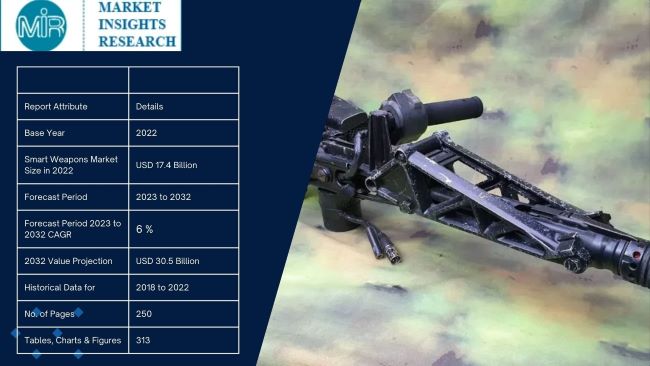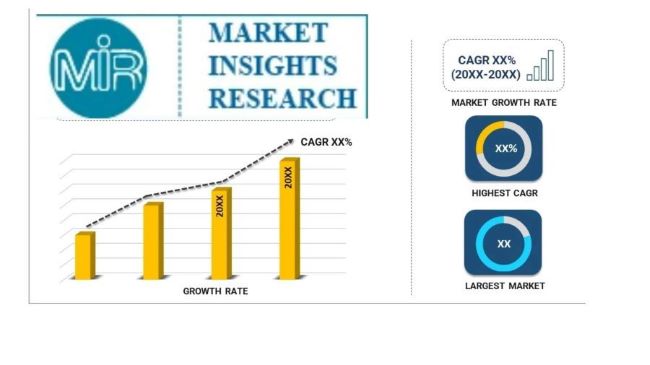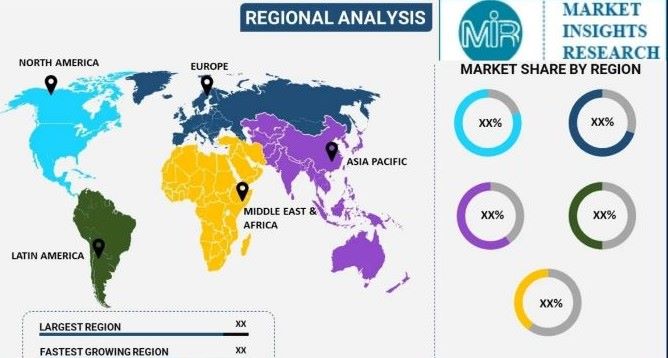Smart Weapons Market Size - By Weapon Type (Missiles, Munitions, Guided Rockets, Guided Projectiles, Directed Energy Weapons), By Technology (Infrared, Laser, Global Positioning System (GPS), Radar), By End Use (Land, Airborne, Naval) & Forecast, 2023 – 2032
Published Date: February - 2025 | Publisher: MRA | No of Pages: 240 | Industry: Aerospace | Format: Report available in PDF / Excel Format
View Details Buy Now 2890 Download Sample Ask for Discount Request CustomizationSmart Weapons Market Size - By Weapon Type (Missiles, Munitions, Guided Rockets, Guided Projectiles, Directed Energy Weapons), By Technology (Infrared, Laser, Global Positioning System (GPS), Radar), By End Use (Land, Airborne, Naval) & Forecast, 2023 – 2032
Smart Weapons Market Size
Smart Weapons Market size was valued at USD 17.4 billion in 2022 and is anticipated to grow at a CAGR of over 6% between 2023 and 2032.
The consistent and substantial increase in financial allocations by governments & defense departments for the development, acquisition, and deployment of advanced smart weapon systems are fueling market growth.
To get key market trends

Download Sample Ask for Discount Request Customization
High interference from government regulatory bodies, who have the authority to set rules and regulations on weapons systems, limits the market opportunities for smart weapons. These organizations impose restrictions on weapon development, testing, production, sale, and deployment.
| Report Attribute | Details |
|---|---|
| Base Year | 2022 |
| Smart Weapons Market Size in 2022 | USD 17.4 Billion |
| Forecast Period | 2023 to 2032 |
| Forecast Period 2023 to 2032 CAGR | 6 % |
| 2032 Value Projection | USD 30.5 Billion |
| Historical Data for | 2018 to 2022 |
| No. of Pages | 250 |
| Tables, Charts & Figures | 313 |
| Segments covered | Weapon Type, Technology, End Use, and Region |
| Growth Drivers |
|
| Pitfalls & Challenges |
|
What are the growth opportunities in this market?
Download Sample Ask for Discount Request Customization
COVID-19 Impact
The COVID-19 pandemic impacted several markets including the smart weapons market in 2020. The global defense industry faced disruptions in manufacturing, supply chains, and workforce availability due to lockdowns & social distancing measures. This led to delays in the production, procurement, and delivery of smart weapons. Governments reallocated funds from defense budgets to address healthcare and economic concerns, which constrained military spending on smart weapon systems. International trade restrictions and reduced global demand further hindered market growth.
Smart Weapons Market Trends
The smart weapons market is experiencing several prominent trends. There is a growing emphasis on technological advancements with continuous innovation in guidance systems, AI, and sensors. The development of autonomous smart weapons including drones & unmanned systems is on the rise. Network-centric warfare integration is becoming more prevalent, enhancing military coordination and effectiveness.
Additionally, there is a focus on non-lethal smart weapons, which reduce collateral damage. Cybersecurity concerns are also mounting, given the increased connectivity of these systems. Stricter export control regulations are being imposed, and environmental considerations are shaping the development of more eco-friendly smart weapon technologies. Rapid prototyping and 3D printing are expediting development, while international collaboration is increasing. Lastly, emerging economies are investing in smart weapons, expanding smart weapons market.
Smart Weapons Market Analysis
Learn more about the key segments shaping this market

Download Sample Ask for Discount Request Customization
Wow, lasers have taken over the battlefield! In 2022, the laser game was already worth over $4.5 billion. And experts predict it will keep growing like crazy, at 7% every year until 2032. That's because lasers make weapons way more accurate. They don't just blow stuff up randomly; they hit their targets dead on, which means fewer innocent bystanders get hurt. And get thisthese laser-guided weapons are lightning fast, zipping towards their target at the speed of light. So, they can take out those pesky drones before they even know what hit them. But hold on, there's more. Lasers are not only accurate and fast, they're also surprisingly affordable and easy to use. That makes them a no-brainer for modern armies. No wonder laser technology is becoming the go-to choice for smart weapons, helping our troops outsmart the enemy with precision, speed, and intelligence.
Learn more about the key segments shaping this market
The land segment captured around 50% of the smart weapons market share in 2022 and is expected to generate a market revenue of USD 15 billion by 2032. The increasing importance of asymmetric warfare and counter-insurgency operations has driven the demand for land-based smart weapon systems. These weapons provide militaries with the ability to precisely target insurgents and terrorist threats while avoiding harm to non-combatants. The demand for land-based smart weapons is growing as countries prioritize the enhancement of their land-based defense capabilities to address contemporary security challenges.
Looking for region specific data?

Download Sample Ask for Discount Request Customization
North America region held 30% revenue share of the smart weapons market in 2022. Particularly the U.S., has one of the world's largest defense budgets, with a strong emphasis on technological superiority. This commitment to military modernization fuels the development and procurement of advanced smart weapon systems. North America is home to several major defense contractors and technology companies, fostering innovation & research in smart weapon technologies. This results in the region being at the forefront of advancements in the defense sector.
The U.S. actively promotes the export of its smart weapon systems, leading to a significant share of the global arms trade. The combination of substantial defense budgets, evolving security challenges, technological innovation, and export opportunities has propelled the market growth.
Smart Weapons Market Share
Major companies operating in the smart weapons market are
- BAE Systems plc
- Elbit Systems Ltd
- General Dynamics Corporation
- Israel Aerospace Industries Ltd
- L3Harris Technologies Inc.
- Leonardo S.p.A
- Lockheed Martin Corporation
- MBDA
- Mitsubishi Heavy Industries
- Northrop Grumman Corporation
- Raytheon Technologies Corporation
- Rheinmetall AG
- Saab AB
- Textron Inc.
- Thales Group
- The Boeing Company.
The competitive landscape is characterized by continuous innovation as companies strive to improve their offerings with new technologies, integrations, and partnerships.
Smart Weapons Industry News
- In August 2023, BAE Systems plc entered into an agreement to acquire the Ball Aerospace business from Ball Corporation. The proposed acquisition represents an exceptional opportunity to strengthen its portfolio with significant scale and high-end technology capabilities. Ball Aerospace will gain over USD 2 billion in annual revenue in the growing space, C4ISR, and missile & munitions markets.
This smart weapons market research report includes in-depth coverage of the industry with estimates & forecast in terms of revenue (USD Million) from 2018 to 2032, for the following segments
Click here to Buy Now Section of this Report
By Weapon Type
- Missiles
- Munitions
- Guided rockets
- Guided projectiles
- Guided firearms
- Directed energy weapons
By Technology
- Infrared
- Laser
- Global Positioning Systems (GPS)
- Radar
- Others
By End Use
- Land
- Airborne
- Naval
The above information is provided for the following regions and countries
- North America
- U.S.
- Canada
- Europe
- UK
- Germany
- France
- Italy
- Russia
- Spain
- Rest of Europe
- Asia Pacific
- China
- India
- Japan
- South Kore
- ANZ
- Rest of APAC
- Latin America
- Brazil
- Mexico
- Rest of Latin America
- MEA
- South Africa
- Saudi Arabia
- UAE
- Israel
- Rest of MEA
Table of Content
Report Content
Chapter 1 Methodology & Scope
1.1 Market scope & definition
1.2 Base estimates & calculations
1.3 Forecast calculation.
1.4 Data Sources
1.4.1 Primary
1.4.2 Secondary
1.4.2.1 Paid sources.
1.4.2.2 Public sources
Chapter 2 Executive Summary
2.1 Smart weapons market 3600 synopsis, 2018 - 2032
2.2 Business trends
2.3 Regional trends
2.4 Weapon type trends
2.5 Technology trends
2.6 End-use trends
Chapter 3 Smart Weapons Market Insights
3.1 Impact on COVID-19
3.2 Russia- Ukraine war impact
3.3 Industry ecosystem analysis
3.4 Vendor matrix
3.5 Profit margin analysis
3.6 Technology & innovation landscape
3.7 Patent analysis
3.8 Key news and initiatives
3.8.1 Partnership/Collaboration
3.8.2 Merger/Acquisition
3.8.3 Investment
3.8.4 Product launch & innovation
3.9 Regulatory landscape
3.10 Impact forces
3.10.1 Growth drivers
3.10.1.1 Continuous growth in global arms trade
3.10.1.2 Large investments from government
3.10.1.3 Ongoing advancements in technology
3.10.1.4 Modernization of armed forces
3.10.1.5 Improved operational efficiency and effectiveness of military forces
3.10.2 Industry pitfalls & challenges
3.10.2.1 High interference of government regulatory bodies
3.10.2.2 Export controls and regulations are limiting the growth
3.11 Growth potential analysis
3.12 Porter’s analysis
3.13 PESTEL analysis
Chapter 4 Competitive Landscape, 2022
4.1 Introduction
4.2 Company market share, 2022
4.3 Competitive analysis of major market players, 2022
4.3.1 Company 1
4.3.2 Company 2
4.3.3 Company 3
4.3.4 Company 4
4.3.5 Company 5
4.3.6 Company 6
4.3.7 Company 7
4.4 Competitive positioning matrix, 2022
4.5 Strategic outlook matrix, 2022
Chapter 5 Smart Weapons Market, By Weapon type (USD Million)
5.1 Key trends, by Weapon type
5.2 Missiles
5.3 Munitions
5.4 Guided rockets
5.5 Guided projectiles
5.6 Guided firearms
5.7 Directed Energy Weapons
Chapter 6 Smart Weapons Market, By Technology
6.1 Key trends, by Technology
6.2 Laser
6.3 Infrared
6.4 Radar
6.5 GPS
6.6 Others
Chapter 7 Smart weapons Market, By End-use
7.1 Key trends, by End-use.
7.2 Land
7.3 Airborne
7.4 Naval
Chapter 8 Smart weapons Market, By Region
8.1 Key trends, by region
8.2 North America
8.2.1 U.S.
8.2.2 Canada
8.3 Europe
8.3.1 UK
8.3.2 Germany
8.3.3 France
8.3.4 Italy
8.3.5 Spain
8.3.6 Russia
8.3.7 Rest of Europe
8.4 Asia Pacific
8.4.1 China
8.4.2 India
8.4.3 Japan
8.4.4 South Korea
8.4.5 ANZ
8.4.6 Rest of Asia Pacific
8.5 Latin America
8.5.1 Brazil
8.5.2 Mexico
8.5.3 Rest of Latin America
8.6 MEA
8.6.1 UAE
8.6.2 South Africa
8.6.3 Saudi Arabia
8.6.4 Israel
8.6.5 Rest of MEA
Chapter 9 Company Profiles
9.1 BAE Systems Plc.
9.2 Elbit Systems Ltd.
9.3 General Dynamics Corporation
9.4 Israel Aerospace Industries Ltd.
9.5 L3Harris Technologies Inc.
9.6 Leonardo S.p.A.
9.7 Lockheed Martin Corporation
9.8 MBDA
9.9 Mitsubishi Heavy Industries, Ltd.
9.10 Northrop Grumman Corporation
9.11 Raytheon Technologies Corporation
9.12 Rheinmetall AG
9.13 Saab AB
9.14 Textron Inc.
9.15 Thales Group
9.16 The Boeing Company
- BAE Systems plc
- Elbit Systems Ltd
- General Dynamics Corporation
- Israel Aerospace Industries Ltd
- L3Harris Technologies Inc.
- Leonardo S.p.A
- Lockheed Martin Corporation
- MBDA
- Mitsubishi Heavy Industries
- Northrop Grumman Corporation
- Raytheon Technologies Corporation
- Rheinmetall AG
- Saab AB
- Textron Inc.
- Thales Group
- The Boeing Company.
Related Reports
- Global Aircraft Quick Lock Pin Market By Type (Single Acting, Double Acting), By Application (Civil Aircraft, Military A...
- Global Military Vehicle Tires Market By Type (OEM, Aftermarket), By Application (Combat, Transportation), By Geographic ...
- Aircraft Refueling Trucks Market Report, By Type (Hydrant Dispensers, Tanker Trucks, Jet Refuelers, Small Fuel Trucks, M...
- Global Aircraft Maintenance Stepladder Market By Type (Aluminum Profile, Stainless Steel), By Application (Civil Aircraf...
- Reusable Launch Vehicles Market - By Type (Partially Reusable, Fully Reusable), By Orbit Type (Low Earth Orbit (LEO), Ge...
- Automatic Weapons Market - By Type (Fully Automatic, Semi-Automatic), By Product (Rifles, Machine Guns, Launcher, Cannon...
Table of Content
Will be Available in the sample /Final Report. Please ask our sales Team.
List Tables Figures
Will be Available in the sample /Final Report. Please ask our sales Team.
FAQ'S
For a single, multi and corporate client license, the report will be available in PDF format. Sample report would be given you in excel format. For more questions please contact:
Within 24 to 48 hrs.
You can contact Sales team (sales@marketinsightsresearch.com) and they will direct you on email
You can order a report by selecting payment methods, which is bank wire or online payment through any Debit/Credit card, Razor pay or PayPal.
Discounts are available.
Hard Copy
